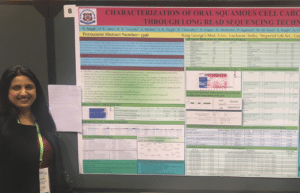 The PacBio team is just back from Chicago, where we saw outstanding talks and posters at the American Association for Cancer Research (AACR) Annual Meeting and enjoyed that city’s well-deserved reputation for exciting weather. We hope everyone remembered to pack their hats and gloves and enjoyed the late-season snow!
The PacBio team is just back from Chicago, where we saw outstanding talks and posters at the American Association for Cancer Research (AACR) Annual Meeting and enjoyed that city’s well-deserved reputation for exciting weather. We hope everyone remembered to pack their hats and gloves and enjoyed the late-season snow!
This year multiple researchers presented work featuring the use of the Iso-Seq method for full-length transcript sequencing in cancer research. The first was a poster presented by Yeung Ho from University of Minnesota, entitled ‘The role of androgen receptor variant AR-V9 in prostate cancer’. The poster describes their discovery that the previously reported structure of AR-V9 was incorrect, and that past experiments characterizing AR-V9 expression patterns had not distinguished between it and the related isoform AR-V7. Read the full publication in Clinical Cancer Research to learn more.
Liqing Tian and Jinghui Zhang from St. Jude’s Children’s Research Hospital also presented work featuring SMRT Sequencing. In their poster on ‘Allelic specificity of immunoglobulin heavy chain (IGH) translocation in B-cell acute lymphoblastic leukemia (B-ALL) unveiled by long-read sequencing’ they shared follow up studies validating a tantalizing lead they discovered in the NALM-6 cell line transcriptome data collected in collaboration with us using the simplified Iso-Seq sample preparation protocol for the Sequel System introduced at last year’s AACR meeting. They showed that though IGH-DUX4 fusion occurs frequently and is thought to be a driver of B-ALL, DUX4 has translocated into the IGH enhancer that is repressed by immunoglobulin allelic exclusion. They theorized that translocation into the dormant enhancer may be favored either because DUX4 is toxic to the pre-B cell or because the translocation blocks VDJ recombination. Without functional B cell receptor, such clones would not survive.
Later in the day, our own Meredith Ashby presented a poster detailing recent improvements to the Iso-Seq analysis workflow, increasing both the speed and reliability of the pipeline that will benefit Sequel System users. The new pipeline can process 1 Sequel SMRT Cell in ~5 hours, and 3 SMRT Cells of data in ~13 hours. In addition, the poster described improved precision in isoform detection with the use of synthetic spike-in variants. Meredith also shared new whole transcriptome data from the breast cancer cell line HCC-1954 and normal breast tissue control, demonstrating that the Iso-Seq method reveals a surprising abundance of both novel isoforms and novel junctions.

On Tuesday afternoon, Neetu Singh from King George’s Medical University presented her poster ‘Characterization of oral squamous cell carcinoma transcriptome through long read sequencing technology’. Neetu reported numerous novel isoforms discovered in patient samples using the Iso-Seq method, including transcripts of genes previously implicated in tumor development. For example, she found that tumor samples but not controls expressed novel isoforms of SCAMP3 and type I keratin KRT-17. Similarly, she found many isoforms of KRT6, KRT14, and KRT16 gene fusions.
Interested in the Iso-Seq method for your project? We invite you to enter our upcoming Iso-Seq SMRT Grant Program: Connect the Dots with the Iso-Seq Method. As highlighted in the terrific science presented by PacBio users at AACR this year, full-length transcript sequencing with PacBio allows users to see the complete picture of splice variants, novel isoforms, and gene fusions. Tell us how the Iso-Seq method for RNA sequencing will drive new discoveries in your human-focused research for a chance to win sequencing on the Sequel System. Visit the grant submission website to learn more and get your entry ready for when the SMRT Grant opens May 1.